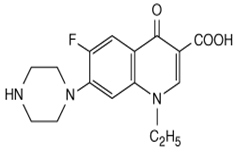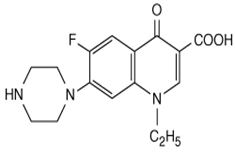 Français
Français Antibiotic Drugs
Norfloxacin
Norfloxacin is a synthetic, first generation broad-spectrum bactericidal fluoroquinolone antibiotic.
Chemical structure
Its empirical formula is C16H18FN3O3 and the MW is 319.34.The structural formula is:

Mechanism of action
Norfoxacin inhibits the enzyme bacterial DNA gyrase and prevents replication of bacterial DNA during bacterial growth and reproduction.
Pharmacokinetics
Food can delay absorption of norfloxacin. Norfloxacin has a unique property i.e. it penetrates well into tissues of the genitourinary tract. Approximately 30% of a dose is eliminated unchanged in the urine thus producing high urinary concentrations. Urinary excretion is decreased by probenecid.
Antimicrobial spectrum
Norfloxacin is active against many gram-positive bacteria and gram-negative bacteria. Relatively long post-antibiotic effect. Norfloxacin is less potent than ciprofloxacin and is not used to treat systemic infections.
Indication, administration and dosage
| Condition | Description | Dosage (adults) |
| Urinary Tract infection | Uncomplicated UTI's (cystitis) due to E. coli, K. pneumoniae, or P. Mirabilis | 400 mg 12 hourly for 3 days |
| Uncomplicated UTI's due to other indicated organisms | 400 mg 12 hourly for 7-10 days | |
| Complicated UTI's | 400 mg 12 hourly for 10- 21 days | |
| Sexually Transmitted Diseases | Uncomplicated gonorrhoea | 800 mg single dose |
| Prostatitis | Acute or chronic | 400 mg 12 hourly for 28 days |
Precautions, contraindications and warnings
Norfloxacin should be taken at least one hour before or at least two hours after a meal or ingestion of milk and/or other dairy products. Multivitamins, other products containing iron or zinc, antacids containing magnesium and aluminium, sucralfate, or Didanosine, chewable/buffered tablets or the paediatric powder for oral solution, should not be taken within 2 hours of administration of norfloxacin. Tablets of norfloxacin should be taken with a glass of water and patients receiving norfloxacin should be well hydrated.
Norfloxacin is contraindicated in patients with history of hypersensitivity, tendinitis, or tendon rupture with norfloxacin or any other fluoroquinolone.
Adverse reaction
Side effects of norfloxacin are dizziness, nausea, headache, abdominal cramps, anorexia, diarrhea, constipation, dyspepsia, flatulence, tingling of the fingers, vomiting, tendonitis, tendon repture, liver toxicity, kidney toxicity.
Technical Description on Norfloxacin
Norfloxacin is a synthetically derived, first generation fluoroquinolone (FQ) antibiotic.
Chemical structure
Its molecular formula is C16H18FN3O3 and the MW is 319.34.The chemical struture is
Preparations available
Oral: 400 mg tablets
Mechanism of action
Norfloxacin has a bactericidal action and it causes inhibition of bacterial DNA synthesis. Exactly norfloxacin inhibits the DNA gyrase enzyme present in the bacteria which leads to hindrance in the normal supercoil formation of the DNA. It also inhibits the process of relaxation of the DNA which has undergone supercoiling and leads to increased damage to the DNA.
The cells of mammals have the enzyme topoisomerase II instead of DNA gyrase or topoisomerase IV which possesses very little affinity for norfloxacin resulting in minimal damage to the host tissue.
Microbiology
Norfloxacin is active against:
Gram-positive aerobes
- Staphylococcus aureus
- Staphylococcus epidermidis and saprophyticus
- Streptococcus agalactiae
- Enterococcus faecalis
Gram-negative aerobes
- E.coli
- Proteus mirabilis and vulgaris
- Enterobacter aerogenes and cloacae
- N. gonorrhoeae
- Klebsiella pneumoniae
- Pseudomonas aeruginosa
- Serratia marcescens
Resistance
Like other fluoroquinolones, resistance is mainly because of chromosomal mutation (Quinolone-Resistance Determining Regions {QRDRs}) forming a DNA gyrase or topoisomerase IV with reduced affinity for norfloxacin. Another common mechanism is reduced permeability/increased efflux of norfloxacin across bacterial membranes. Like other FQs norfloxacin, FQ-resistant mutants are not easily selected hence resistance develops slowly to FQs.
Due to the unique mechanism of action of fluoroquinolones plasmid mediated transferable resistance perhaps does not occur.
A Qnr protein has been seen that offers protection to the DNA gyrase from damage by the FQs. Also modification of norfloxacin can be caused by a different type acetyltransferase which is similar to the one which modifies aminoglycoside.
Cross resistance is seen within the FQs.
Microorganisms like Klebsiella pneumoniae, acinetobacter and pseudomonas aeruginosa have developed the most resistance to norfloxacin.
Norfloxacin is usually active against the microorganisms which are not sensitive to nalidixic acid.
Pharmacokinetics
After oral intake about 30 to 40% of norfloxacin is absorbed. Maximal plasma levels occur after one to two hours. The presence of food can delay absorption. The plasma protein binding is about 14%. It is extensively distributed. Norfloxacin has a unique property i.e. it penetrates well into tissues of the genitourinary tract. It crosses the placenta. Comparatively high concentrations are achieved in bile.
The t1/2 of norfloxacin is three to four hours. Approximately 30% of a dose is eliminated unchanged in the urine within 24 hours, thus producing high urinary concentrations. Urinary excretion is mainly by tubular secretion and glomerular filtration and is decreased by probenecid, but plasma concentrations of norfloxacin are usually not affected. Norfloxacin undergoes little metabolism, probably in the liver, and a number of metabolites have been reported in urine, some showing antibacterial activity. Approximately 30% of an oral dose is excreted in the faeces.
Therapeutic uses and dosage
| Condition | Dosage (adults) |
| Urinary system infection (uncomplicated) | 400 mg 12 hourly for 3 or 7-10 days |
| Urinary system infection (complicated) | 400 mg 12 hourly for 10- 1 days |
| Acute or chronic infection of prostate | 400 mg BD for 28 days |
| Sexually Transmitted Diseases(mainly uncomplicated gonorrhoea) | A single 800 mg dose |
All the infections mentioned above in the table are caused by the susceptible organism as mentioned in the microbiology section.
- There should be a time gap of two hours after eating food or a time period of one hour prior to consumption of food.
- Hydration must be maintained well in patients taking norfloxacin.
Drug interactions
- Didanosine, antacids, multivitamins, sucralfate, formulations containing iron or zinc, should not be taken within two hours of administration of norfloxacin.
- Like other FQs, norfloxacin can lead to increase in serum levels of theophylline when prescribed simultaneously.
- Like other FQs, norfloxacin may enhance the effects of oral anticoagulants.
- Like other FQs, norfloxacin when given with glyburide can rarely lead to severe decrease in the plasma glucose levels.
- Like other FQs, norfloxacin inhibits CYP1A2 in vitro. When used with other drugs metabolized by CYP1A2 like ropinirole, clozapine, caffeine, tizanidine, theophylline it may lead to increased substrate drug concentrations when given in normal doses.
- Probenecid inhibits the renal elimination of norfloxacin thereby increasing its levels.
- Nitrofurantion may antagonize the antibacterial effect of norfloxacin in the urinary tract.
- Simultaneous prescription of norfloxacin with NSAIDS can lead to increased probability of convulsions.
Precautions
- Tendon Rupture and tendinopathy
Like other FQs norfloxacin can lead to an enhanced chance of inflammation and rupture of the tendons. The risk increases in elderly persons, patients taking steroids and persons with kidney or liver dysfunction.
- Central Nervous System Effects
Norfloxacin like other FQs can lead to seizures, increased intracranial pressure tremors, hallucinations, restlessness, anxious behaviour, confusion, depressive state, vivid dreams, and decreased sleep.
- Clostridium difficile-Associated enterocolitis
Clostridium difficile-associated enterocolitis can be seen with norfloxacin like other antibiotics.
- Peripheral Neuropathy
Rarely large or small sized neurons may be affected by polyneuropathy due to norfloxacin leading to altered sensations.
- Rarely, haemolytic reactions can occur in glucose-6-phosphate dehydrogenase deficient patients receiving quinolones including norfloxacin.
- Musculoskeletal Disorders
An increased incidence of musculoskeletal disorders i.e. joint pain and inflammation and Tendinopathy has been observed.
- Deterioration of Myasthenia Gravis
Like other FQs, norfloxacin can lead to deterioration of weakness of muscles in patients of myasthenia gravis.
- Rarely needle-shaped crystals can occur in the urine of patients taking norfloxacin and they are more likely to occur if the recommended dose is exceeded or the patient is not well hydrated leading to inadequate urine output.
- Hypersensitive reactions can be seen with norfloxacin which can be fatal rarely.
Special populations
- Pregnancy
It is a Category C drug. Animal studies have not shown any teratogenic effect.
- Lactation
It is not known whether norfloxacin is secreted during lactation.
- Children
There are no studies regarding the safety of norfloxacin in persons aged < 18 years of age.
Contraindications
Norfloxacin is contraindicated in persons with a prior event of hypersensitivity to norfloxacin or any member of the quinolone class of antimicrobial agents.
Adverse reactions
The most common adverse effects seen with norfloxacin are:
- Decreased appetite, loose stools, increased sweating, decreased body movements
- Giddiness, headache, cramps in the abdomen
- Vomiting, constipation, tingling sensations
- Pyrexia, dryness of the mouth, increased itching, skin rashes, increased sleepiness.
- Inflammation of the bursa in joints, blurring of vision, depression, painful menstruation, oedema
The laboratory adverse changes seen were:
- Increased SGOT, SGPT, decreased WBC count
- Decreased platelet count, increased urine protein
- Decreased hematocrit and hemoglobin
- Increased eosinophils
- Increased alkaline phosphatase